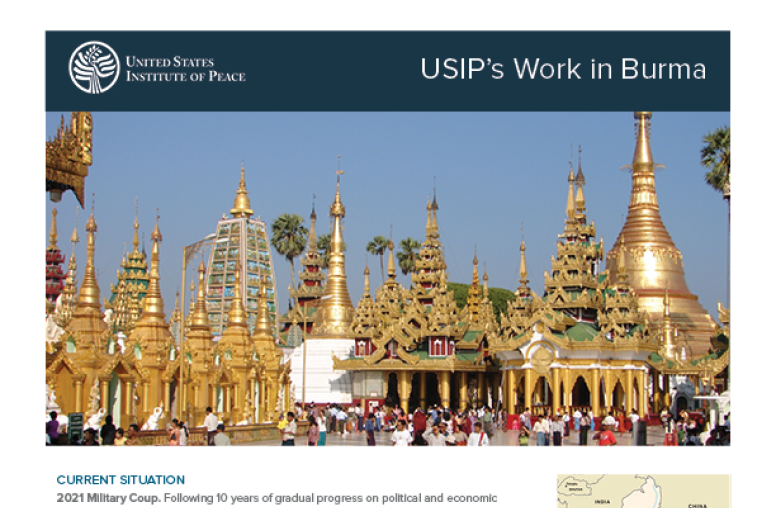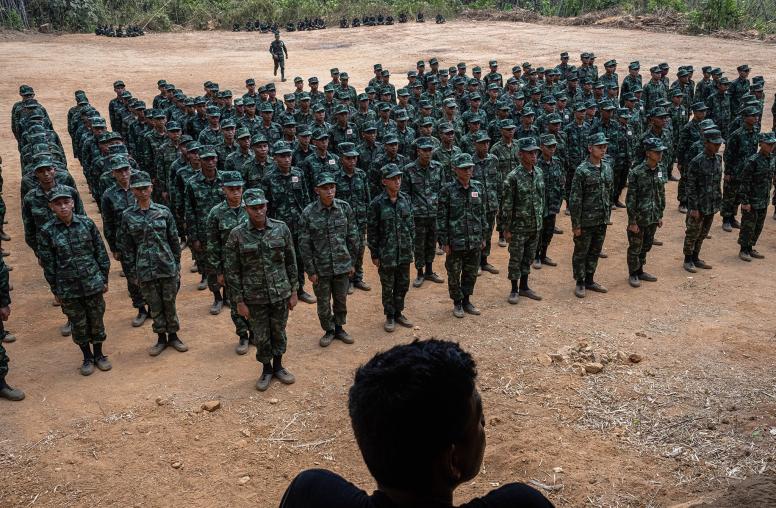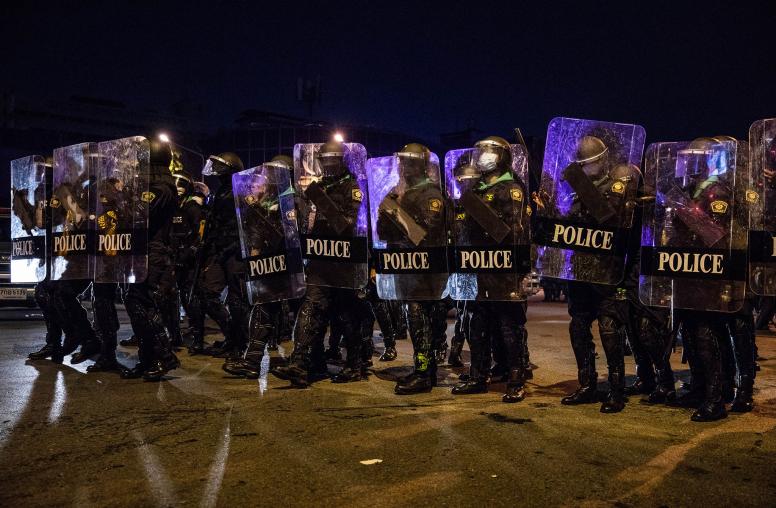Burma’s Northern Shan State and Prospects for Peace
Armed conflict between the Burmese Army and various ethnic armed organizations continue to threaten the peace process of the National League for Democracy government led by Aung San Suu Kyi. This Brief focuses on conflict dynamics to provide an overview of resurgent conflict patterns in northern Shan State over the past two years, outlines the armed groups involved, their competing interests, the human rights effects on the civilians in the area, and how the fighting has affected the nationwide ceasefire.
Summary
- Increased armed conflict between the Burmese Army and several ethnic armed organizations in northern Shan State threaten the nationwide peace process.
- Thousands of civilians have been displaced, human rights violations have been perpetrated by all parties, and humanitarian assistance is being increasingly blocked by Burmese security forces.
- Illicit economic activity—including extensive opium and heroin production as well as transport of amphetamine stimulants to China and to other parts of Burma—has helped fuel the conflict.
- The role of China as interlocutor between the government, the military, and armed actors in the north has increased markedly in recent months.
- Reconciliation will require diverse advocacy approaches on the part of international actors toward the civilian government, the Tatmadaw, ethnic armed groups, and civil society. To facilitate a genuinely inclusive peace process, all parties need to be encouraged to expand dialogue and approach talks without precondition.
Introduction
Even as Burma has transitioned—beginning in late 2010—from decades of civil war and military rule to greater democracy, long-standing and widespread armed conflict has resumed between several ethnic armed organizations (EAOs) and the Burmese armed forces (Tatmadaw). Early in 2011, a 1994 ceasefire agreement broke down as relations deterioriated in the wake of the National League for Democracy government’s refusal to permit Kachin political parties to participate in the elections that ended the era of military rule in the country. At the same time, tensions over economic interests and territory escalated.
The major EAOs operating in the north of Shan State—which occupies almost a quarter of Burma’s land area and juts out to the east, bordering China, Laos, and Thailand—include the Ta-ang National Liberation Army (TNLA), the (ethnic Chinese) Myanmar Democratic Alliance Army, and the Kachin Independence Army.1 After the end of the ceasefire agreement in 2011, Kachin base areas along the Burma-China border in Kachin State (just to the north) soon became hubs for the formation or remobilization of a host of other EAOs. These included the United League of Arakan or Arakan Army of Kachin State and the reformed TNLA/Palaung State Liberation Front. These groups soon expanded their operations into northern Shan State alongside Kachin allies, where fighting raged well into 2013.
Looming over the entire area is the United Wa State Party, Burma’s largest nonstate armed group, which boasts more than twenty-five thousand heavily armed troops and a self-administered zone abutting the China border. A patchwork of government-aligned militias, called Pyithu Sit (People’s Militia), operate there, many involved in drug production and smuggling, and some working with Tatmadaw units on operations.2
Escalating Conflict
The northern Shan State conflict is complex and defies easy classification. The dynamics of the fighting vary from place and time and between groups. Fighting sharply escalated in February 2015 when one faction of the former ceasefire group, the Myanmar Democratic Alliance Army, attacked the capital city of their former enclave, the border town of Laukkai, displacing tens of thousands of civilians and resulting in extensive government casualties. Multiple Tatmadaw light infantry divisions were deployed to clear the area, resulting in extensive use of heavy artillery and helicopter gunship and jet fighter air strikes.3 This has produced arguably the most intensive and widespread fighting in the area since the 1980s—a marked shift from the low-intensity counterinsurgency warfare that characterized the civil war for twenty-five years.
The conflict escalated further in November 2016 with coordinated attacks by the Myanmar Democratic Alliance Army, the TNLA, the Arakan Army, and the Kachin Independence Army— formalized as the North Alliance-Burma (or North Alliance)—on the key Burma-China border town of Muse, which resulted in a dozen civilian and security force casualties, thousands of civilians fleeing to China or south, and the suspension of border trade. The fighting spread over several weeks, the rebels seizing and holding the border town of Mong Ko before being driven out by government artillery and air strikes. Hit and run ambushes by North Alliance units are reported to have inflicted significant Tatmadaw casualties, which provoked major multiunit sweeps and civilian suffering or displacement.
Even as Burma has transitioned from decades of civil war and military rule to greater democracy, longstanding and widespread armed conflict has resumed.”
Determining the circumstances of reported armed exchanges is difficult. Reasons are typically related to direct military operations, protection or interdiction of economic interests, protection of civilians, or retribution attacks. Another explanation is military pressure to force the EAOs to sign the ceasefire accord. TNLA operations against drug production and smuggling by government-aligned militias in Kutkai township have drawn in Tatmadaw troops to support their militia allies.4
To further complicate matters, armed clashes are on the increase between the TNLA and a Nationwide Ceasefire Agreement (NCA) signatory, the Restoration Council of Shan State (also known as the Shan State Army-South). These clashes are mostly thought to be over territory and economic interests, but have heightened tensions between Shan and Ta-ang communities across northern Shan State.
More Displacement, Restrictions on Humanitarian Assistance
The conflict has had a devastating effect on civilians. The UN Office Coordinating Humanitarian Affairs (OCHA) estimates the number of internally displaced people as close to one hundred thousand.5 The exact figure could be higher because OCHA does not enumerate displacement where heavy fighting has been reported. Many civilians are displaced several times a year, which interrupts agricultural cycles and affects livelihoods and food security.
Since early 2016, international and Burmese humanitarian agencies have reported increasingly difficult access to internally displaced people in areas outside government control, aid convoys being turned back or travel authorizations (especially for foreign staff of international agencies) refused. The deteriorating security situation grants the Burma security services license to further restrict travel. In June 2017, three Burmese journalists attending a TNLA drug-burning ceremony were arrested by the Tatmadaw and charged under Section 17(1) of the draconian 1908 Unlawful Associations Act, which could result in a three-year prison term. The arrests evinced widespread concern that the act heralded a crackdown on reporting on nonsignatory EAOs and human rights violations.6
Shan, Ta-ang, and international human rights groups have reported widespread and systematic violations by Tatmadaw troops and their Pyithu Sit allies. These include extrajudicial executions, forced relocations, forced labor to carry supplies, human shielding during operations, and routine torture and ill-treatment of civilians, some of it captured on mobile phones and distributed through social media.7 In mid-2016, the Tatmadaw made a rare admission that its troops tortured and killed five men from a village east of Lashio. Yet the Tatmadaw often refuse to acknowledge or investigate widespread reports of abuses in other parts of Shan State, despite calls from the UN Special Rapporteur Yanghee Lee to visit the areas. EAOs have been routinely accused of perpetrating abuses against civilians—including indiscriminate fire into civilian areas, forced recruitment, forced labor, torture, ill-treatment, and extortion—claims their leaders routinely deny.
Impacts on the Peace Process
Despite early promises of a more inclusive peace process under Aung San Suu Kyi’s National League for Democracy government, the increased fighting in the north has contributed to more misunderstanding, mistrust, and marginalization of nonsignatory EAOs and their communities (whose combined forces make up more than 80 percent of all nonstate armed groups). The lead-up to the second Panglong 21st Century Conference in May was marked by the government’s sharply increased denunciation of the North Alliance and an insistence that attendance must be preceded by signing the NCA. In December, the Shan State regional assembly passed a motion labeling members of the North Alliance as terrorist organizations (a similar attempt in the national parliament was voted down). A series of pro-Tatmadaw civilian rallies were staged soon after. In July, soldiers distributed leaflets in Lashio warning residents of an imminent terrorist attack by the Kachin Independence Army and the TNLA, which the groups strongly denied.
Statements from the Tatmadaw Commander in Chief Senior-General Min Aung Hlaing and the State Counselor Aung San Suu Kyi over the last year have been almost indistinguishable. Suu Kyi’s first statement as head of the National Reconciliation and Peace Center denounced the use of violence by the Northern Alliance and defended the role of the Tatmadaw.8 In March, she prematurely announced the pledge by five members of the Union Nationalities Federal Council (UNFC) to sign the NCA, and warned other groups—meaning the Northern Alliance—to be “extremely careful.” This misunderstanding led to the surprise UNFC boycott of the Panglong conference.9 At the last minute, however, facilitated by China, the northern groups attended as special guests.
The increasing efforts by the United Wa State Party to be a coordinating leader of the northern groups is a significant development. Ahead of the Panglong conference in May, it formed the Federal Political Negotiations and Coordination Committee following a conference at its capital Panshang, which the North Alliance attended. The UNFC, formerly the main grouping of nonsignatory EAOs, was blindsided. Its nonattendance at the Panglong conference raised questions of its future role in the process and what the new Wa-led grouping had to offer. Already the Wa State Party has articulated its rejection of the NCA and deplored the dismissive approach of the Tatmadaw to ethnic grievances, signaling that it would pursue a tougher negotiating line and support the northern groups.10
China has increased its efforts to include the North Alliance into the peace process, and succeeded, clearly illustrating its growing influence.11 This may have been a coup for Chinese influence but was otherwise pyrrhic in that EAO representatives did not attend any substantive meetings.
Conclusion
The intensity of the attacks in northern Shan State and the critical rhetoric by government and military leaders against ethnic communities has further eroded trust in an already weak peace process.12 Many leaders of EAOs and their civilian support base feel a strong sense of betrayal over the lack of development, minimal political inclusion, and routine human rights abuses. These are deep grievances, dating back decades. The intensity of the growing fighting in northern Shan State is a key element in the dearth of trust in the sincerity of the Aung San Suu Kyi government to pursue peace.
It is important to analyze the flaws and missed opportunities of the ceasefire process so far to inform ongoing discussions and to find ways for international interlocutors to bridge the growing divides between all sides to this complex and growing war. International actors need to be more proactive in urging regular talks with all northern Shan State actors between the government and military, and to pursue routine consultations with a range of civil society actors in the area.
International actors also need to realize that armed conflict has escalated even as a partial ceasefire is being consolidated. These two processes require diverse advocacy approaches toward the civilian government and the Tatmadaw. Support for EAOs and civil society must differ if it is to make a difference. Last, and perhaps most significant, all sides need to be encouraged to seek negotiations without hard preconditions attached.
Notes
- See “Township Map—Shan State (North),” Myanmar Information Management Unit, February 2015, http://themimu.info/sites/themimu.info/files/documents/Tsp_Map_Shan-North_MIMU 1251v01_23Feb2015_A3_0.pdf.
- John Buchanan, Militias in Myanmar (Yangon: Asia Foundation, July 2016).
- Anthony Davis, “Tatmadaw quietly launches largest war since Myanmar’s independence,” Jane’s Defence Weekly, May 20, 2015.
- Thu Thu Aung, “TNLA field clearing suspended by air strikes,” Myanmar Times, February 26, 2016, www.mmtimes.com/index.php/national-news/19197-tnla-field-clearing-suspended-by-air-strikes.html.
- UNOCHA, “Myanmar: IDP Sites in Kachin and northern Shan states,” June 2017, http://reliefweb.int/map/myanmar/myanmar-idp-sites-kachin-and-northern-shan-states-may-2017.
- David Scott Mathieson, “Gagging the messengers of Myanmar’s wars,” Asia Times, July 6, 2017, www.atimes.com/article/gagging-messengers-myanmars-wars/.
- Ta-ang Women’s Organization, “Trained to Torture,” June 2016, http://en.palaungwomen.com/index.php/82-reports/97-trained-to-torture (No longer available online).
- Shan Human Rights Foundation, “Torture, extra judicial killing, and use of civilians as human shields by Burma army during new offensive,” June 1, 2016, http://shanhumanrights.org/index.php/news-updates/247-torturen-extrajudicial-killing-and-use-of-civilians-as-human-shields-by-burma-army-during-new-offensive; see also “Covering all the Bases,” Global New Light of Myanmar, July 21, 1–2.
- National Reconciliation and Peace Center, “Announcement on Situation of Armed Conflicts in the Northeast Shan State,” Announcement no. 1/2016, November 23, 2016, https://progressivevoicemyanmar.org/2016/11/23/announcement-on-situation-of-armed-conflicts-in-the-northeast-shan-state/.
- “UNFC Position Statement on 21st Century Panglong Second Conference,” May 23, 2017.
- “Process of Wa State’s Consultation and Negotiation with the Government of Myanmar on Modification of Nationwide Ceasefire Agreement, Central Committee of United Wa State Party,” April 30, 2017.
- See Yun Sun, “China and Myanmar’s Peace Process,” Special Report no. 201 (Washington, DC: US Institute of Peace, March 2017); Bertil Lintner, “China uses carrot and stick in Myanmar,” Asia Times, February 28, 2017.
- Vanessa Johanson, “Creating an Inclusive Burmese Peace Process,” Peace Brief no. 223 (Washington, DC: US Institute of Peace, May 2017).
About this Brief
Focusing on conflict dynamics, this Peace Brief outlines the resurgent patterns of armed violence in the townships of Burma’s northern Shan State between 2015 and 2017 in the context of Burma’s transition to democratic rule. It is supported by the Asia Center at the United States Institute of Peace. David Mathieson is an independent analyst based in Rangoon working on peace and conflict issues in contemporary Burma. From 2006 to 2016 he was the Senior Researcher on Burma for Human Rights Watch.



